A little upwards movement was expected. After a slight new low price has turned and moved higher.
The short-term Elliott wave count remains mostly the same but the short-term target is recalculated.
Summary: For the very short term, a small counter trend bounce may end most likely about 1,301 to 1,305. If price keeps rising through this first target, then the next expectation would be about 1,310. Thereafter, the downwards trend should resume.
The Elliott wave target is at 1,220. A target calculated using the flag is about 1,238.
Three long-term targets are now calculated for cycle wave c to end. Confidence in a new downwards trend may be had with a new low below 1,160.75.
New updates to this analysis are in bold.
Grand SuperCycle analysis is here.
Last monthly charts are here. Video is here.
MAIN ELLIOTT WAVE COUNT
WEEKLY CHART – TRIANGLE
This is the preferred wave count.
Cycle wave b may be a complete regular contracting triangle. If it continues further, then primary wave E may not move beyond the end of primary wave C above 1,365.68.
Four of the five sub-waves of a triangle must be zigzags, with only one sub-wave allowed to be a multiple zigzag. Wave C is the most common sub-wave to subdivide as a multiple, and this is how primary wave C for this example fits best.
There are no problems in terms of subdivisions or rare structures for this wave count. It has an excellent fit and so far a typical look.
This wave count would expect a cycle degree trend change has recently occurred. Cycle wave c would most likely make new lows below the end of cycle wave a at 1,046.27 to avoid a truncation.
Primary wave E should exhibit reasonable weakness as it comes to an end. Triangles often end with declining ATR, weak momentum and weak volume.
If this weekly wave count is correct, then cycle wave c downwards should develop strength, ATR should show some increase, and MACD should exhibit an increase in downwards momentum.
Three targets are calculated for cycle wave c. Cycle wave a lasted 4.25 years. Cycle wave b may be over in 3.17 years. Cycle wave c may last a minimum of 2 years and possibly up to 5 years.
DAILY CHART – TRIANGLE
Cycle wave c must subdivide as a five wave structure, either an impulse or an ending diagonal. An impulse is much more common and that shall be how it is labelled unless overlapping suggests a diagonal should be considered.
A new trend at cycle degree should begin with a five wave structure on the daily chart, which will be labelled minor wave 1.
Minor wave 2 is now labelled as a complete triple zigzag.
A base channel is drawn about minor waves 1 and 2. There will be bounces and consolidations on the way down. Bounces may find resistance at the upper edge of the base channel. Towards its middle or end the power of a third wave may be able to break below support at the lower edge of the base channel.
Within minor wave 3, no second wave correction may move beyond the start of its first wave above 1,323.61.
It is possible that minor wave 3 may end with a selling climax; it may exhibit a swift and strong fifth wave to end the impulse. This behaviour is typical of commodities, and this tendency is especially prevalent for third wave impulses.
HOURLY CHART
Minor wave 3 may only subdivide as an impulse.
Minute wave ii may be unfolding as an expanded flat correction. Within minute wave ii, minuette wave (b) remains within the most common range of 1 to 1.38 times the length of minuette wave (a). A target is calculated for minuette wave (c) that expects the most common Fibonacci ratio to minuette wave (a).
Minuette wave (c) must complete as a five wave structure. It looks like it is unfolding as an impulse, which is the most common structure for C waves within flat corrections.
Minuette wave (c) would be extremely likely to move at least slightly above the end of minuette wave (a) at 1,299.25 to avoid a truncation and a very rare running flat.
Expanded flat corrections do not fit neatly into trend channels, so a channel about their C waves may be used as an indication of when the correction is over. The acceleration channel is drawn about minuette wave (c) for this purpose. Draw the first trend line from the end of subminuette wave i to the last high, then pull a parallel copy lower to contain all of minuette wave (c). When this channel is clearly breached by downwards movement, that may be an indication that minute wave ii may be over and minute wave iii downwards may have begun.
Minute wave ii may not move beyond the start of minute wave i above 1,323.61.
WEEKLY CHART – DOUBLE ZIGZAG
It is possible that cycle wave b may be an incomplete double zigzag or a double combination.
The first zigzag in the double is labelled primary wave W. This has a good fit.
The double may be joined by a corrective structure in the opposite direction, a triangle labelled primary wave X. The triangle would be about four fifths complete.
Within multiples, X waves are almost always zigzags and rarely triangles. Within the possible triangle of primary wave X, it is intermediate wave (B) that is a multiple; this is acceptable, but note this is not the most common triangle sub-wave to subdivide as a multiple. These two points reduce the probability of this wave count.
Intermediate wave (D) may be complete. The (B)-(D) trend line is almost perfectly adhered to with the smallest overshoot within intermediate wave (C). This is acceptable.
Intermediate wave (E) should continue to exhibit weakness: ATR should continue to show a steady decline, and MACD may begin to hover about zero.
Intermediate wave (E) may not move beyond the end of intermediate wave (C) below 1,160.75.
This wave count may now expect downwards movement for several weeks.
Primary wave Y would most likely be a zigzag because primary wave X would be shallow; double zigzags normally have relatively shallow X waves.
Primary wave Y may also be a flat correction if cycle wave b is a double combination, but combinations normally have deep X waves. This would be less likely.
This wave count has good proportions and no problems in terms of subdivisions.
Intermediate wave (E) should subdivide as a zigzag labelled minor waves A-B-C. Zigzags subdivide 5-3-5, exactly the same the start of an impulse.
The preferred wave count labels downwards movement minor waves 1-2-3, and this wave count labels downwards movement minor waves A-B-C. At the daily and hourly chart levels, the subdivisions for both wave counts are seen in the same way.
ALTERNATE ELLIOTT WAVE COUNT
WEEKLY CHART
If Gold is in a new bull market, then it should begin with a five wave structure upwards on the weekly chart. However, the biggest problem with this wave count is the structure labelled cycle wave I because this wave count must see it as a five wave structure, but it looks more like a three wave structure.
Commodities often exhibit swift strong fifth waves that force the fourth wave corrections coming just prior to be more brief and shallow than their counterpart second waves. It is unusual for a commodity to exhibit a quick second wave and a more time consuming fourth wave, and this is how cycle wave I is labelled. The probability of this wave count is low due to this problem.
Cycle wave II subdivides well as a double combination: zigzag – X – expanded flat.
Cycle wave III may have begun. Within cycle wave III, primary wave 1 may now be complete. The target for primary wave 2 is the 0.618 Fibonacci ratio of primary wave 1. Primary wave 2 may not move beyond the start of primary wave 1 below 1,160.75.
A black channel is drawn about primary wave 1. Primary wave 2 may breach the lower edge of this channel.
Cycle wave III so far for this wave count would have been underway now for 27 weeks. It should be beginning to exhibit some support from volume, increase in upwards momentum and increasing ATR. However, volume continues to decline, ATR continues to decline and is very low, and momentum is weak in comparison to cycle wave I. This wave count lacks support from classic technical analysis.
TECHNICAL ANALYSIS
WEEKLY CHART
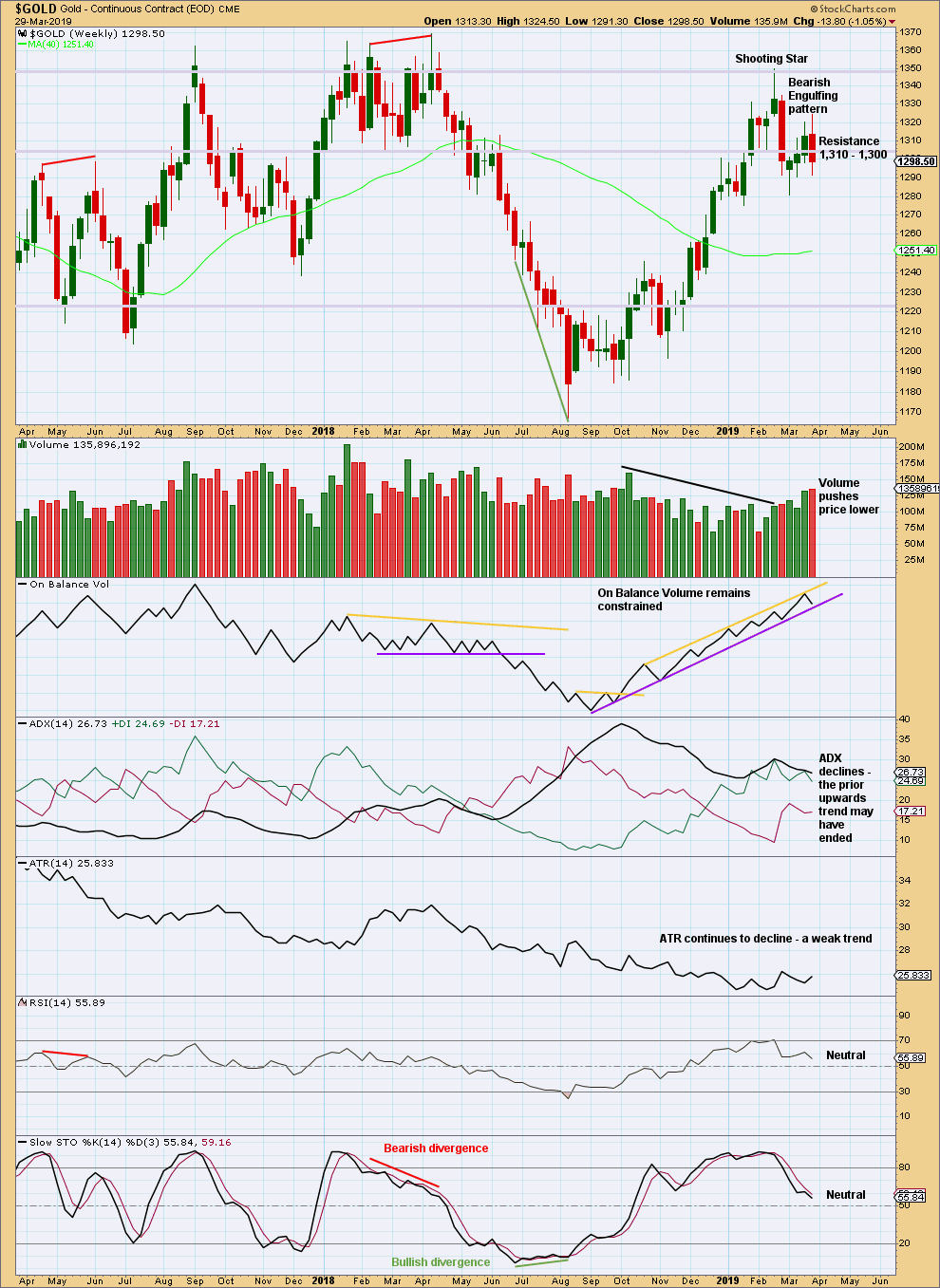
Click chart to enlarge. Chart courtesy of StockCharts.com.
Support and resistance about 1,310 – 1,300 has now been breached in both directions multiple times. This area of prior strong support and resistance has by now been weakened.
With volume pushing price lower, it looks like more downwards movement may continue here at least for the short term.
DAILY CHART
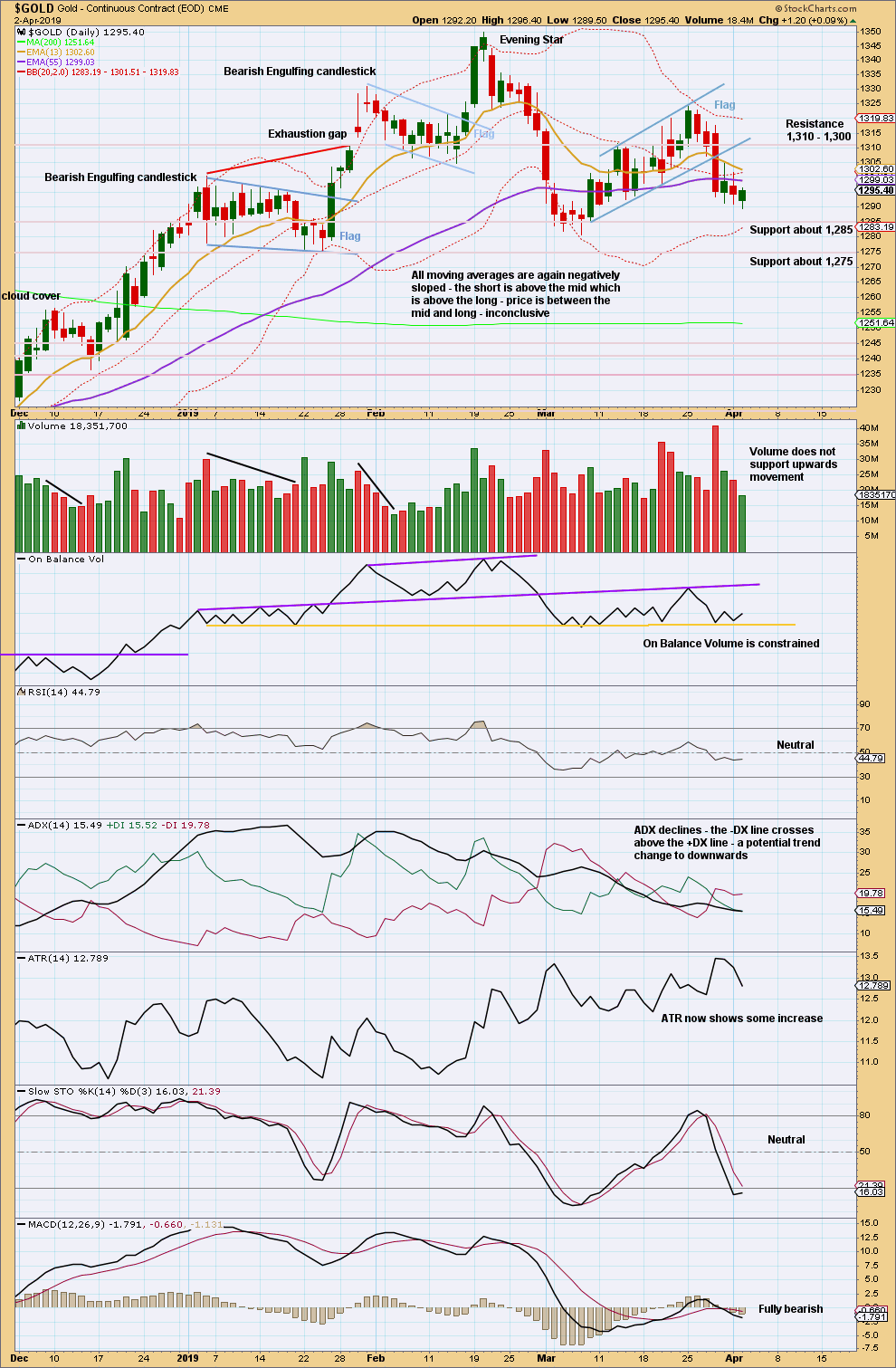
Click chart to enlarge. Chart courtesy of StockCharts.com.
The target using the flag pole is 1,238.
Tuesday completes another small range day. Downwards movement is weak. Support for On Balance Volume here may assist to halt a fall in price.
GDX WEEKLY CHART
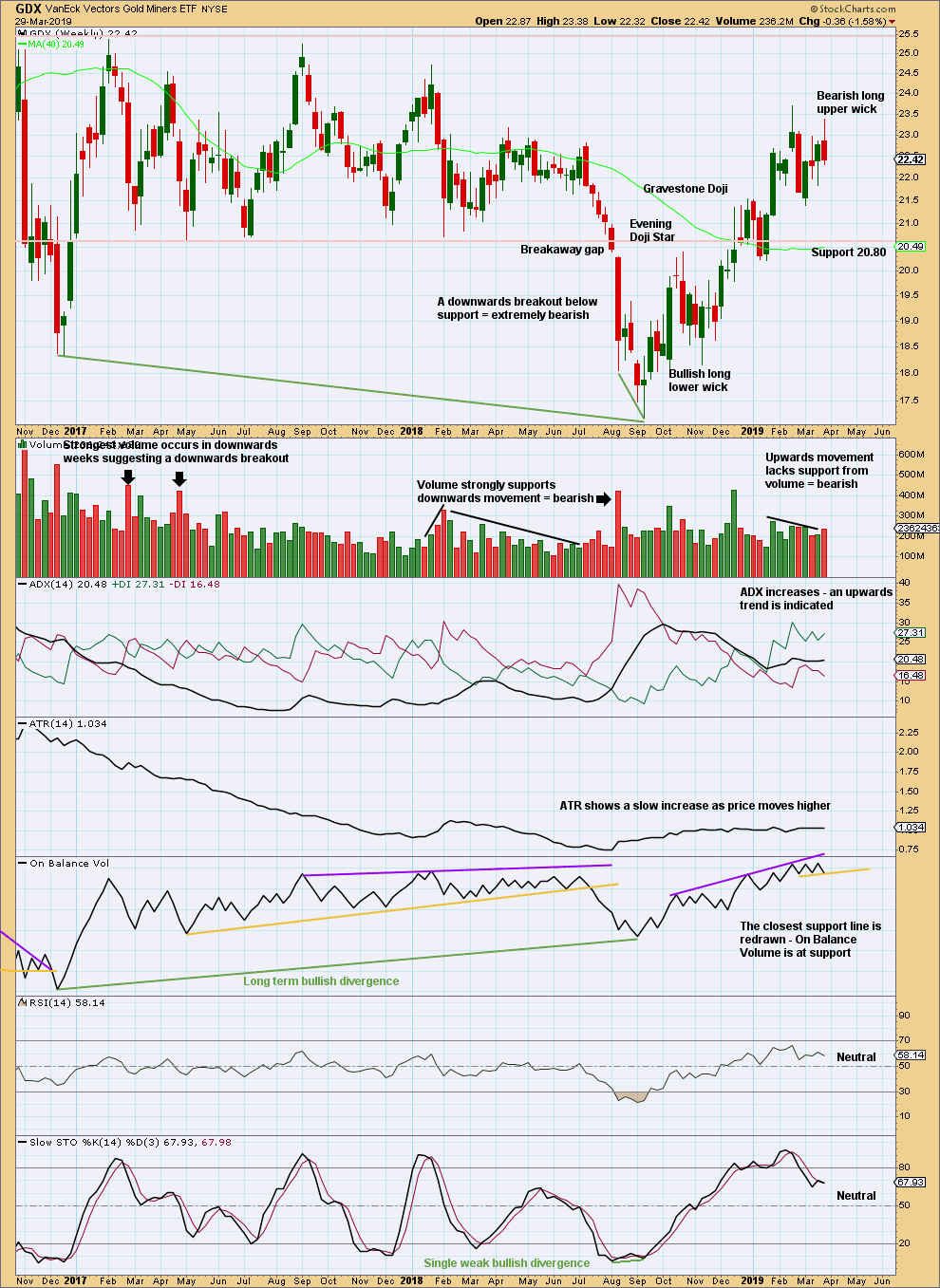
Click chart to enlarge. Chart courtesy of StockCharts.com.
A new swing low below the prior low of the week beginning 22nd January at 20.22 would confirm a trend change. For now GDX may be assumed to remain in an upwards trend. There is a series of higher highs and higher lows from the low in September 2018.
For the short term, a bearish long upper wick and volume pushing price lower for the last week suggest more downwards movement.
GDX DAILY CHART
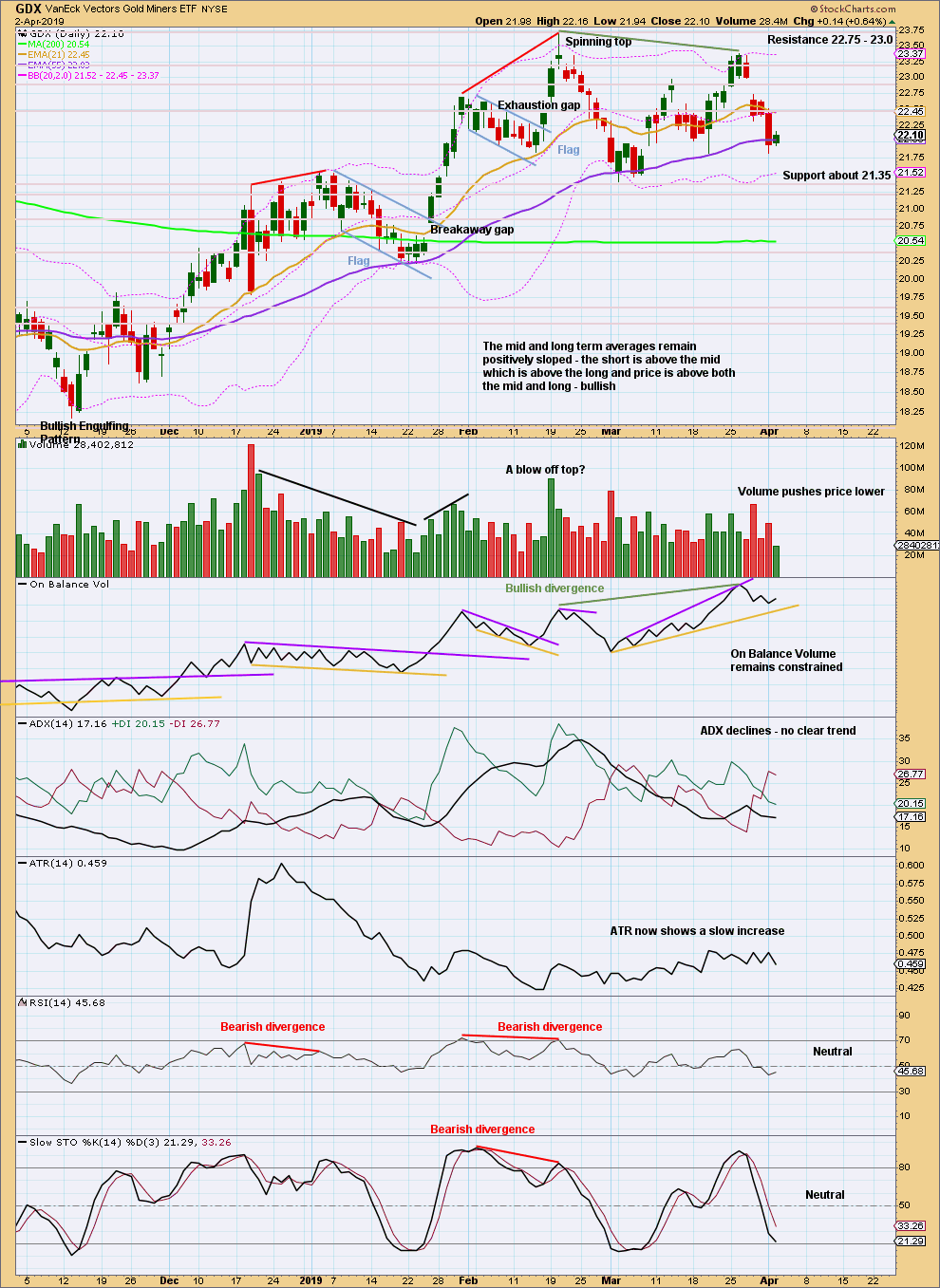
Click chart to enlarge. Chart courtesy of StockCharts.com.
At the daily chart level, the view of an upwards trend may be in doubt with a new swing low on the 1st of March 2019 that moved below the prior swing low of the 14th of February 2019. At that stage, the series of higher highs and higher lows was no longer intact and a trend change was possible.
Since then price has not made another higher high. For the short term, price remains range bound. Currently, price may be within a downwards swing to support. If price reaches support about 21.35 and Stochastics is oversold at the same time, the downwards swing may end there.
Published @ 05:38 p.m. EST.
—
Careful risk management protects your trading account(s).
Follow my two Golden Rules:
1. Always trade with stops.
2. Risk only 1-5% of equity on any one trade.

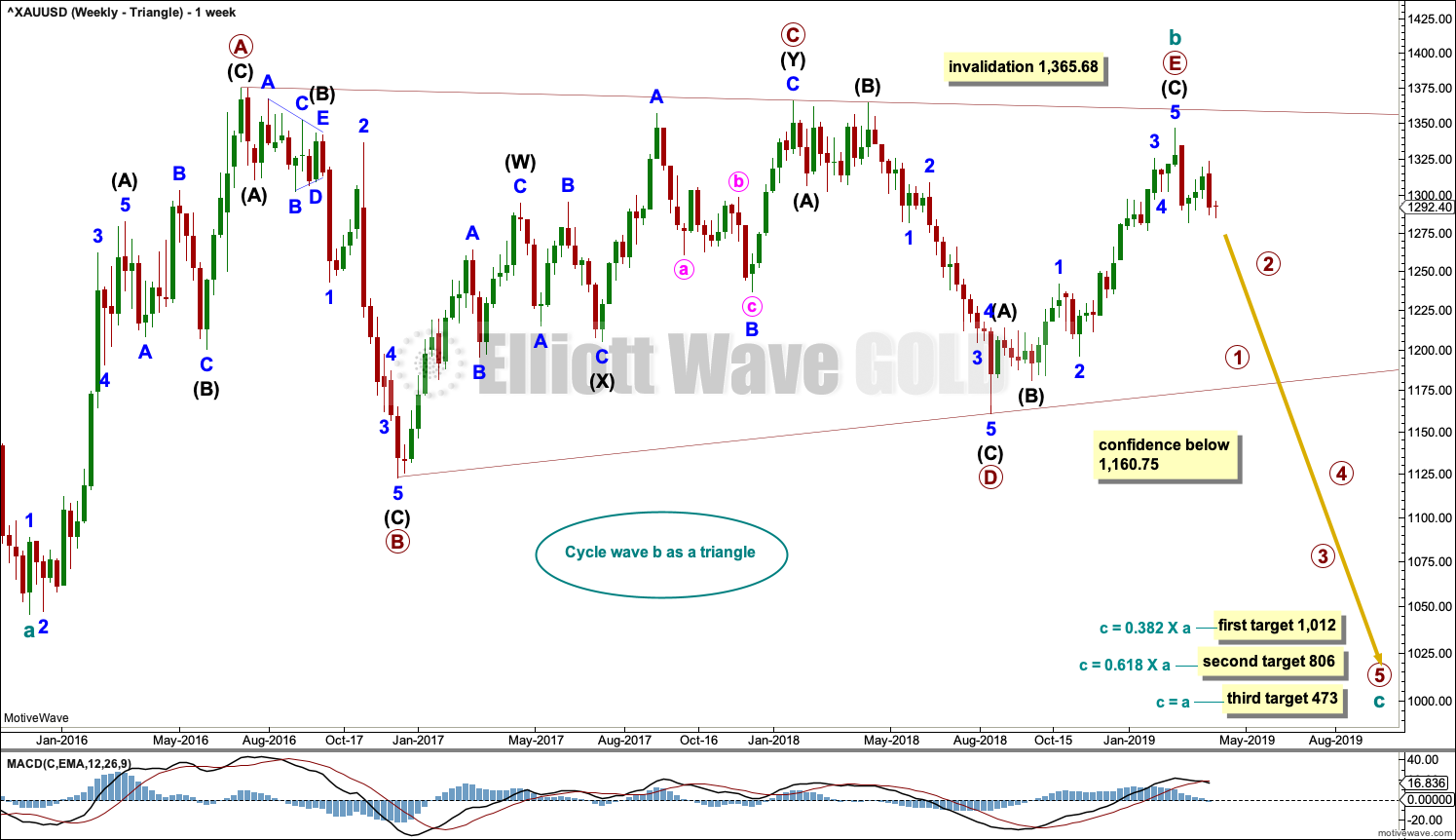
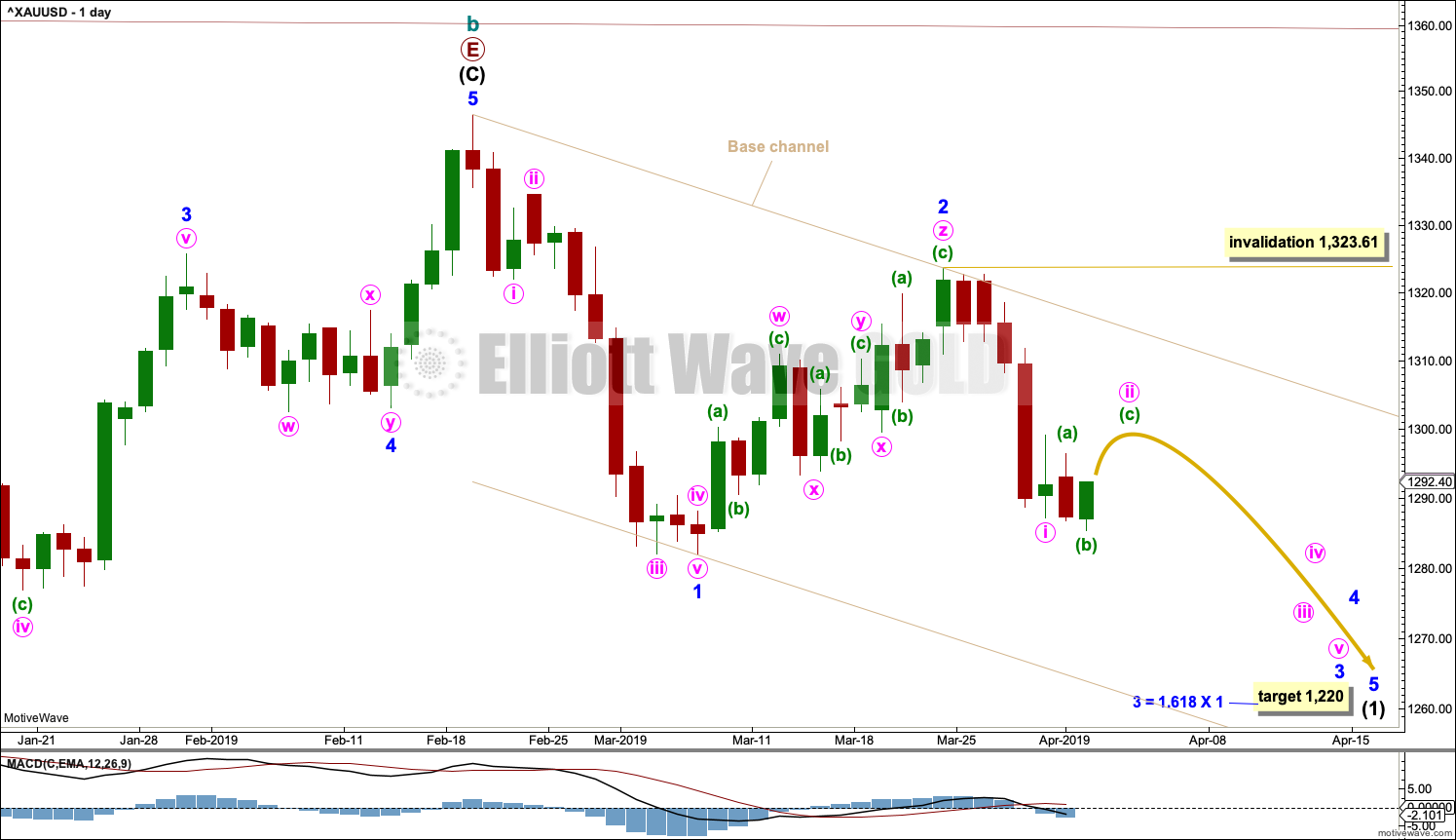
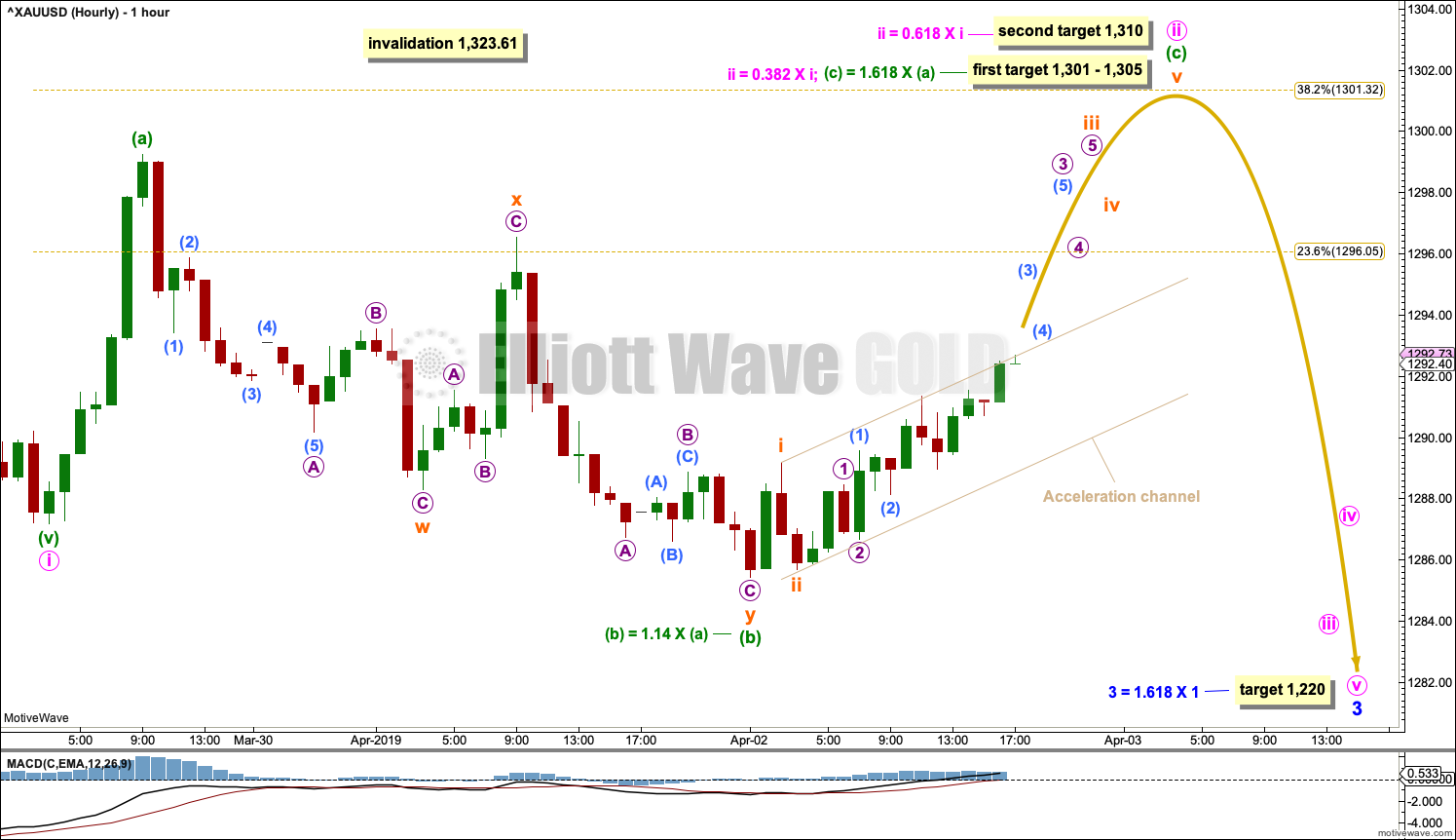
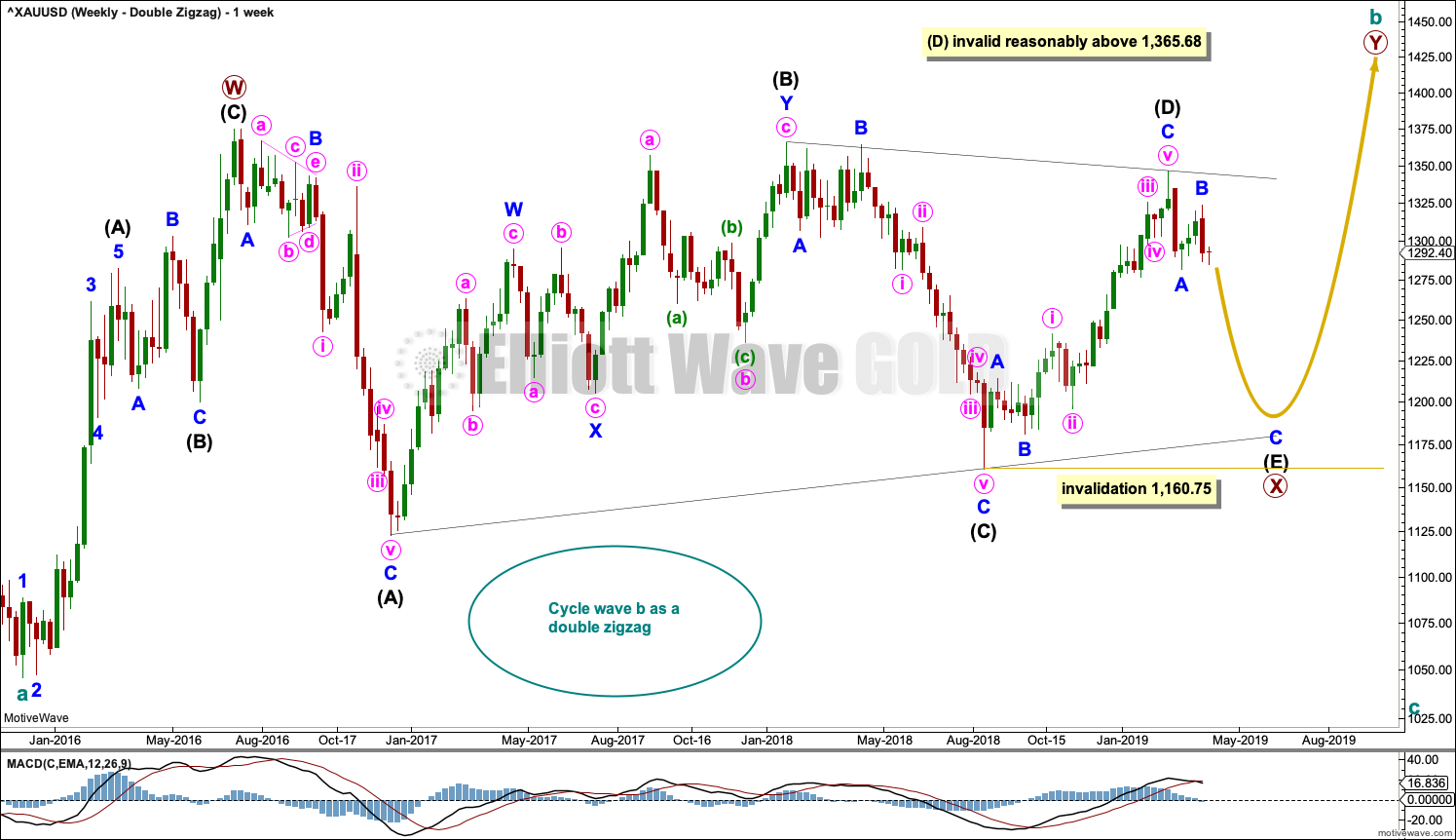
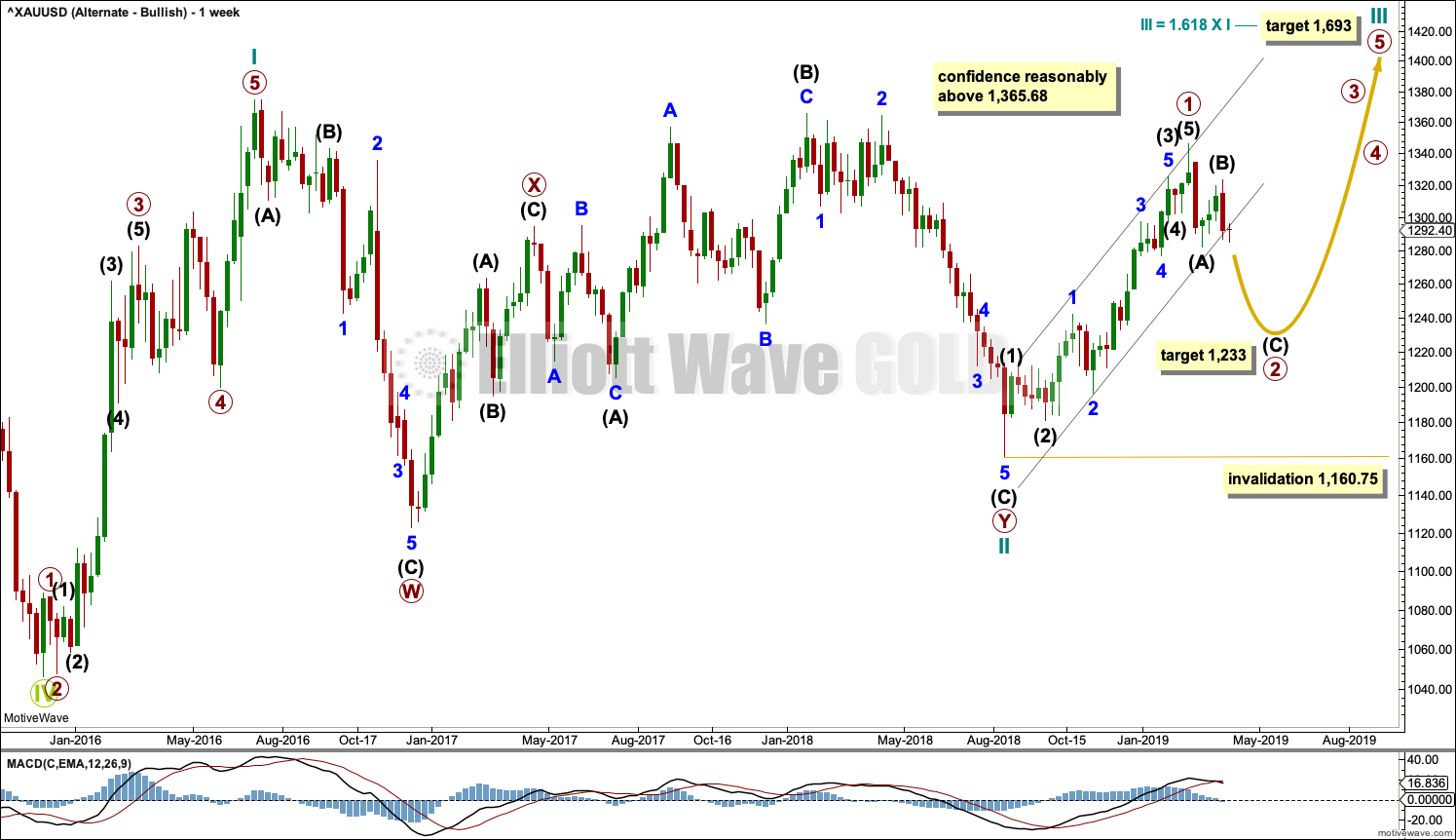
Hourly chart updated:
If minute ii is unfolding as a flat correction then minuette (c) still would be incomplete, despite the channel I had drawn in the analysis above being breached by downwards movement. Minuette (c) has not moved above the end of minuette (a) yet, it needs to do so to avoid a truncation and an extremely rare running flat.
Targets remain the same. The channel is redrawn.
I may need to relabel minute ii as a combination, but no matter what EW structure it may be I cannot yet see it complete.
Hi Dreamer,
thanks for that. Yes I think we are nearly at the turn. I think we have one last wave V to come
Possible. Either way, a top is likely very close.
Lara, is there some significant reason you do TA not EW on GDX ? My simple mind would prefer EW.
Yes. For normal looking EW structures the volume has to be very significant. Volume on GDX just doesn’t appear to be enough. Its threes don’t always look like threes and its fives don’t always look like fives.
Something to keep your 👁 on today. There appears to be enough squiggles for a top in oil and the hourly trendline is about to be breached. Price so far has come within a dollar of the .618 retrace (Lara’s 🎯) . If you do go short, know that this is for aggressive traders as there is no confirmation of a top and price may still move higher. Good luck. 🧐. Maybe we can get a midweek update from Lara today.